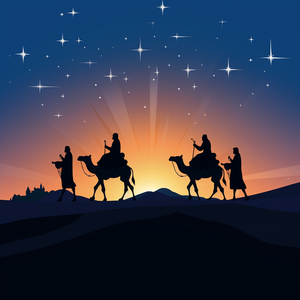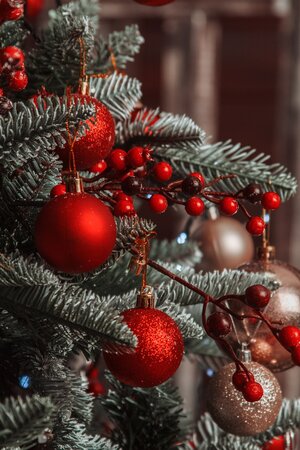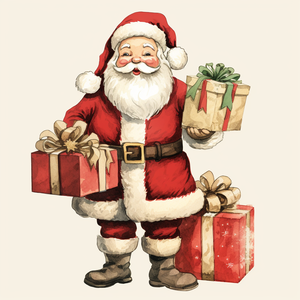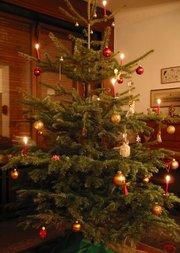Christmas
|
|
Christmas, also known as the Mass of Christ, is a Christian holiday celebrated on December 25 to commemorate the birth of Jesus. According to the Christian gospels, Jesus was born in Bethlehem to Mary and Joseph during the Roman census. His birth fulfilled Jewish prophecies of a messiah from the house of David. Early Christians focused more on Epiphany, when the Magi visited baby Jesus. The exact date of his birth was determined centuries later.
In predominantly Christian nations, Christmas holds great economic importance and is also celebrated secularly in countries with smaller Christian populations. It is characterized by gift exchanges within families and the arrival of Santa Claus or other mythical figures. Despite the influence of American and British Christmas themes in literature and media, local and regional Christmas traditions remain diverse and vibrant.
| Contents |
The story of Christmas
The story of Christ's birth has been handed down for centuries, based primarily on the Christian gospels of Matthew and Luke. The gospels of Mark and John do not address the childhood of Jesus, and those of Matthew and Luke give somewhat differing accounts, Luke's being closest to the public impression of the Christmas story and the version most often read in Christmas services.
According to Luke, Mary learned from an angel that she was with child, by virtue of impregnation without intercourse by the Holy Spirit. Shortly thereafter, she and her husband Joseph left their Nazareth home to travel to Joseph's ancestral home, Bethlehem of Judea, to enroll in the census ordered by the Roman emperor, Augustus. Finding no room in inns in the town, they set up primitive lodgings in a stable. There Mary gave birth to Jesus in a manger, which has been translated in various ways, most commonly a feeding trough or stall. Christ's birth in Bethlehem of Judea, the home of the house of David from which Joseph was descended, fulfilled the prophecy of Isaiah.
Matthew's gospel begins by recounting the genealogy and virgin birth of Jesus, and then skips to the coming of the Wise Men from the East to the home where Christ was staying after his birth in Bethlehem of Judea. This leaves ambiguous at whose home they were staying and whether Mary and Joseph were residents of Nazareth or, as their access to a home in Bethlehem suggests, of Bethlehem. The wise men, or Magi, first arrived in Jerusalem and reported to the local King Herod that they had seen a star heralding the birth of a king. Further inquiry led them to Bethlehem of Judea and the home of Mary and Joseph. They presented Jesus with treasures of "gold, frankincense, and myrrh". While staying the night, each Wise Man had a dream that contained a divine warning that King Herod had murderous designs on the child. Resolving to hinder the ruler, they returned home without notifying Herod of the success of their mission. Matthew then reports that the family next fled to Egypt to escape the murderous rampage of Herod, who had decided to have the children of Bethlehem killed in order to eliminate any local rivals to his power. When Jesus and his family returned to Israel, it was then that they settled in Nazareth, where they believed they might live more anonymously.
Another aspect of Christ's birth which has passed from the gospels into popular lore is the announcement by angels to nearby shepherds of Jesus' birth . Some Christmas carols refer to the shepherds observing a huge star directly over Bethlehem, and following it to the birthplace. The Magi, who Matthew reports seeing a giant star as well, have been variously interpreted as "wise men" or as kings. They are supposed to have come from Arabia, where they could have gotten their gifts of "gold, frankincense, and myrrh". Astronomers and historians have sought with varying success to explain what combination of traceable celestial events might explain the appearance of a giant star that had never before been seen.1
The major gaps in narrative details between Matthew and Luke, the absence of any reference to Christ's birth in the other gospels, and the fact that even the accounts of Matthew and Luke were written decades later, without confirmation by eyewitnesses, have led to much speculation about the accuracy of these reports. As one of the tenets of their faith, Christians accept the veracity of the story of Christmas, apparent difficulties reconciling the different versions of events notwithstanding.
Dates of celebration
Christmas was not among the earliest festivals of the Christians. Efforts to fix a date for the birth of Christ began some two centuries after his death, as the Catholic Church began to establish its traditions. Christmas is now celebrated on December 25 in catholic, protestant, and most orthodox churches. The Coptic, Jerusalem, Russian, Serbian and Georgian orthodox churches celebrate Christmas on January 7. This date results from their having accepted neither the reforms of the Gregorian calendar nor the Revised Julian calendar, with their ecclesiastic December 25 thus falling on the civil (Gregorian) date of January 7 from 1900 to 2099. The Armenian Church places much more emphasis on the Epiphany, the visitation by the Magi, than on Christmas.
Some scholars suggest that December 25 is a date of convenience chosen for other reasons, related to the time of Emperor Constantine. Prior to the celebration of Christmas, December 25th in the Roman world was the Natalis Solis Invicti, the Birthday of the Unconquerable Sun.
Dates for the more secular aspects of the Christmas celebration are similarly varied. In the United Kingdom, the Christmas season traditionally runs for twelve days following Christmas Day. These twelve days of Christmas, a period of feasting and merrymaking, end on Twelfth Night, the Feast of the Epiphany. This period corresponds with the liturgical season of Christmas. Medieval laws in Sweden declared a Christmas peace (julefrid) to be twenty days, during which fines for robbery and manslaughter were doubled. Swedish children still celebrate a party, throwing out the Christmas tree (julgransplundring), on the 20th day of Christmas (January 13, Knut's day).
Countries that celebrate Christmas on December 25th recognize the previous day as Christmas Eve, and vary on the naming of December 26th. In the Netherlands, Germany, Scandinavia, and Poland, Christmas Day and the following day are called First and Second Christmas Day. In many European and Commonwealth countries, December 26th is referred to as Boxing Day, while in Ireland and Romania it is known as St. Stephen's Day.
Customs and celebrations
An enormous number of customs, with either secular, religious, or national aspects, surround Christmas, and vary from country to country. Most of the familiar traditional practices and symbols of Christmas, such as the Christmas tree, the Christmas ham, the Yule Log, holly, mistletoe, and the giving of presents, were adapted or appropriated by Christian missionaries from the earlier midwinter holiday of Yule. This celebration of the winter solstice was widespread and popular in northern Europe long before the arrival of Christianity, and the word for Christmas in the Scandinavian languages is still today the pagan jul (=yule). The Christmas tree is believed to have first been used in Germany.
Rather than attempting to suppress such popular pagan feast days, Pope Gregory I allowed Christian missionaries to give them a Christian reinterpretation, while permitting most of the associated customs to continue with little or no modification.2 The give and take between religious and governmental authorities and celebrators of Christmas continued through the years. Places where conservative Christian theocracies flourished, as in Cromwellian England and in the early New England colonies, were among those where celebrations were suppressed.3 After the Russian Revolution, Christmas celebrations were banned in the Soviet Union for the next seventy-five years. A few present day Christian churches, notably the Jehovah's Witnesses, some Puritan groups, and some ultra-conservative fundamentalist denominations, still view Christmas as a pagan holiday not sanctioned by the Bible, and do not celebrate it.
Secular customs
Since the customs of Christmas celebration largely evolved in Northern Europe, many are associated with the Northern Hemisphere winter, whose motifs are prominent in Christmas decorations and in the Santa Claus myth.
Santa Claus and other bringers of gifts
Gift-giving is a near-universal part of Christmas celebrations. The concept of a mythical figure who brings gifts to children derives from Saint Nicholas, a good hearted bishop of 4th-century Asia Minor. The Dutch modeled a gift-giving Saint Nicholas around his feast day of December 6. In North America, English colonists adopted aspects of this celebration into their Christmas holiday, and Sinterklaas became Santa Claus, or Saint Nick. In the UK, whilst this name is widely known, "Father Christmas" is more common, and is also used in many West African countries. In the Anglo-American tradition, this jovial fellow arrives on Christmas Eve on a sleigh pulled by reindeer, climbs down the chimney, leaves gifts for the children, and eats the food they leave for him. He spends the rest of the year making toys and keeping lists on the behavior of the children.
The French equivalent of Santa, P貥 No묬 evolved along similar lines, eventually adopting the Santa image Haddon Sundblom painted for a worldwide Coca-Cola advertising campaign in the 1930s. In some cultures Santa Claus is accompanied by Knecht Ruprecht, or Black Peter. In some versions, elves in a toy workshop make the holiday toys, and in some he is married to Mrs. Claus. Many shopping malls in North America and the United Kingdom have a holiday mall Santa Claus whom children can visit to ask for presents.
In many countries, children leave empty containers for Santa to fill with small gifts such as toys, candy, or fruit. In the United States, children hang a Christmas stocking by the fireplace on Christmas Eve, because Santa is said to come down the chimney the night before Christmas to fill them. In other countries, children place their empty shoes out for Santa to fill on the night before Christmas, or for Saint Nicholas on December 5. Gift giving is not restricted to these special gift-bringers, as family members and friends also bestow gifts on each other.
Timing of gifts
In many countries, Saint Nicholas Day remains the principal day for gift giving. In much of Germany, children put shoes out on window sills on the night of December 5, and find them filled with candy and small gifts the next morning. In such places, including the Netherlands, Christmas day remains more a religious holiday. In other countries, including Spain, gifts are brought by the Magi at Epiphany on 6 January.
One of the many customs of gift timing is suggested by the song Twelve Days of Christmas, celebrating an old British tradition of gifts each day from Christmas to Epiphany. In most of the world, Christmas gifts are given at night on Christmas Eve, or in the morning on Christmas Day. Until the recent past, gifts were given in the UK to non-family members on Boxing Day.
Christmas cards
Christmas cards are extremely popular in the United States and Europe, in part as a way to maintain relationships with distant relatives and friends, and with business acquaintances. Many families enclose an annual family photograph, or a family newsletter telling activities of family members during the preceding year.
Decorations
Decorating a Christmas tree with lights and ornaments, and the decoration of the interior of the home with garlands and evergreen foliage, particularly holly and mistletoe, are common traditions. In North and South America and to a lesser extent Europe, it is traditional to decorate the outside of houses with lights, and sometimes with illuminated sleighs, snowmen, and other Christmas figures.
The traditional Christmas flower is the poinsettia. Other popular holiday plants are holly, red amaryllis and Christmas cactus.
Municipalities often sponsor decorations as well, hanging Christmas banners from street lights or placing Christmas trees in the town square. In the United States, decorations once commonly included religious themes. This practice has led to much adjudication, as opponents insist that it amounts to the government endorsing one particular religious faith.
Social aspects and entertainment
In many countries, businesses, schools, and communities have Christmas parties and dances during the several weeks before Christmas Day. Christmas pageants, common in Latin America, may include a retelling of the story of the birth of Christ. Groups may go carolling, visiting neighborhood homes to sing Christmas songs. Others are reminded by the holiday of man's fellowship with man, and do volunteer work, or hold fundraising drives for charities.
On Christmas Day or on Christmas Eve, a special meal of Christmas dishes is usually served, for which there are traditional menus in each country. In some regions, particularly in Eastern Europe, these family feasts are preceded by a period of fasting. Candy and treats are also part of the Christmas celebration in many countries.
Religious customs and celebrations
The religious celebrations begin with Advent, the anticipation of Christ's birth, around the start of December. These observations may include Advent carols and Advent calendars, sometimes containing sweets and chocolate for children. Christmas Eve and Christmas Day services may include a midnight mass or a Mass of the Nativity, and feature Christmas carols and hymns.
Other faiths have emphasized their own winter holidays to serve as a Christmas surrogate, including Judaism's Hanukkah, which has evolved a similar tradition of gift-giving. Christmas has some acceptance in the Islamic world, where Jesus is regarded as a prophet. Many secular aspects of Christmas are becoming common in developed Muslim nations.
Northern Europe
Christmas_Decoration.jpg
In Germany and the Netherlands, the celebration of Saint Nicholas Day resembles the Christmas of the English-speaking world. Sinterklaas brings presents on Sinterklaasavond, the evening of December 5, to good children. He wears a red bishop's dress with a red mitre, rides a white horse over the rooftops, and is assisted by many mischievous helpers called zwarte Pieten (black Peters). In some parts of Germany, Austria, and Switzerland, the frightening Knecht Ruprecht also appears, to the chagrin of many children.
In recent years, the Dutch have started to celebrate Christmas Eve with Santa as well. Shopkeepers prefer to start the Christmas season right after Sinterklaasavond, while others argue that the foreign, commercial Christmas impinges on the traditional Sinterklaas celebrations. Considering the ancestry of Santa Claus, Sinterklaas there is in competition with himself.
In Germany, Christmas traditions vary by region. Following Saint Nicholas Day, which is mostly for children, Christmas gift-giving usually takes place on Christmas eve, with gifts put under the Christmas tree. The feast typically takes place at lunch on December 25, and usually involves poultry (typically roast goose). The gifts may be brought by the Weihnachtsmann, who resembles St. Nicholas, or by the Christkind, a sprite-like child who may represent the baby Jesus. Commercially, the Striezelmarkt becomes a Christmas gift production center, boasting the specialities of the Dresden region, from ceramics and prints to various delicacies which are shipped worldwide.
In Sweden and Denmark, businesses traditionally invite their employees to a Christmas sm?sbord lunch (the julbord or jullunch. Julefrokost in Danish) in the weeks before Christmas. In recognition of the threat of holiday food poisoning, Swedish newspapers run seasonal laboratory tests of restaurant jullunches, warning of the danger of cold meats and mayonnaise left out at room temperature. The Christmas feast focuses on baked ham, but there are wide regional variations as to what day it is best served. The most entrenched and nationally unifying Swedish and Danish Christmas custom is perhaps that of watching a Disney special at 3 PM on Christmas Eve.
The Norwegian Christmas celebration begins with feasting on December 24, followed by a visit by Julenissen, who brings gifts to children who have behaved. After a quiet December 25, another large celebration follows on Boxing Day, when children may go door to door to receive treats and money from neighbors. Joulupukki (or Christmas Goat) is the Finnish Santa Claus. He travels with a sleigh and reindeer to deliver gifts to good children.
Southern Europe
Modern traditions combine with holdovers from their Roman forebears in the celebrations of Natale, the Italian Christmas. The pagan feast of Saturnalia coincides with the Christian advent, and the holiday season spans from then through Epiphany. Food, religious observances, nativity displays, and gift-giving are prominent. In some regions, presents are brought on Epiphany by La Befana, and in others by Baby Jesus on Christmas day or eve. In recent years Babbo Natale, a Santa Claus-like figure, is becoming more common.
Christmas_ship.jpg
In Greece, a ship is the traditional symbol of Christmas, though the tree has been imported.
Central Europe
In the Czech Republic, Christmas is celebrated mainly on December 24, or Christmas Eve or "open-handed day", when the gifts are given in the evening. December 25 and 26 are also holidays. Gifts are brought by Jež�mp;#353;ek, or "little Jesus". Old traditions include fasting on Christmas Eve until a ceremonial dinner is served, in order to be able to see a "golden pig". The gifts are displayed under the Christmas tree (usually spruce or pine), and people unpack them after the dinner.
Other Czech Christmas traditions involve predictions. Apples are cut crosswise; if a star appears in the core, the next year will be successful, while a cross suggests a bad year. Girls throw shoes over their shoulders; if the toe points to the door, the girl will get married. Another tradition requires pouring molten lead into water and guessing a message from the shapes that appear when it hardens.
In Poland, Christmas Eve is a day first of fasting, then of feasting. The feast begins with the appearance of the first star, and is followed by the exchange of gifts. There are many other traditions in connection with the Christmas Eve supper. It is inevitable that there are 12 dishes on the table and that there is a free place for an unexpected guest. There is straw under the table cloth which is meant to symbolise the place of birth of Christ. No meat except fish is eaten on that day. It is a very popular custom to attend the midnight mass called Pasterka. The following day is often spent visiting friends or celebrated with a family dinner.
Christmas in Slovakia is largely a celebration of family, food, and religious observation. In 2001 a massive nativity scene was constructed and displayed in Bratislava's Plavecky Stvrtok, with plans to disassemble it for future displays in other cities.
In Belarus Christmas is celebrated twice, on December 25 and on January 7, because the country has significant populations of both Catholic and Orthodox faiths. Both dates are official holidays.
Russia
In Eastern Europe, Slavic countries have Ded Moroz ("Grandfather Frost"), who travels in a magical troika, a decorated sleigh drawn by three horses, and delivers gifts to children. He is thought to descend more from Santa Claus than from Saint Nicholas.
Christmas celebration in Russia has been revived since 1992, after decades of government suppression. It centers on the Christmas Eve "Holy Supper", which consists of twelve servings, one to honor each of Jesus' apostles. Russians kept some traditions alive by shifting them to New Year's Day, including the visit by gift-giving "Grandfather Frost" and his "Snowmaiden". Many current customs, including their Christmas tree, or yolka, were brought by Peter the Great, after his western travels in the late 18th century.
United Kingdom
Christmas crackers form an integral part of Christmas celebrations, and the Christmas pantomime is popular with young families. The festival of Nine Lessons and Carols at King's College, Cambridge is a popular religious programme. Every year since 1947 the city of Oslo has presented the British a spruce tree as a token of appreciation for British support during the Second World War. It stands in Trafalgar Square and is the most famous Christmas tree in Britain. The usual Christmas dinner meal is turkey, with christmas pudding or Christmas cakes, often decorated with white icing, as dessert. In the United Kingdom Christmas is sometimes referred to affectionately by the slang terms Crimble or Crimbo.
North America
In the United States and Canada, the Santa Claus traditions are essentially the same. The Christmas tree and skating rink at Rockefeller Center in New York City, and the White House Christmas decorations are hallmarks of the U.S. Christmas. NORAD "tracks" Santa Claus' global transit each year, to wide attention by the mass media.
The focus of secular Christmas in Mexico is the posada. Over a nine day period, groups of townspeople go from door to door, symbolic of visitors to the baby Jesus, and are periodically called inside homes to participate in the breaking of a gift-filled pi.
South America
Religious themes predominate in heavily-Catholic South America. The secular customs and gift-giving in these countries are an admixture of traditions handed down from European and Native American forebears, plus the increasing influence of American culture.
Gift giving traditions include El Niesus (Baby Jesus), who brings gifts to children in Colombia, Chile's Viejo Pasquero (Old Man Christmas), and Brazil's Papai Noel. The latter two resemble Santa Claus. South American "Santas" dress more lightly in keeping with their warmer Christmas, and have adopted a number of means, from ladders to trampolines, to enter homes at night. Gift giving in Argentina occurs on January 6, or "Three Kings Day," when children leave shoes under their beds to be filled with snacks or small gifts by the Magi, who stop off on their way to Bethlehem.
Nativity scenes are featured in South American Christmas, both in homes and in public places. In regions with large numbers of Native American descendants, such as Peru, the figures are often hand-carved in a centuries-old style. As in Mexico, village processions acting out the events surrounding the birth of Christ are also common. Family Christmas meals are important, their contents as varied as the number of South American countries. Christmas lights are a nearly universal, and with the summery weather, fireworks displays are also found, especially over the cities of Brazil.
Asia
The Philippines celebrates the world's longest Christmas season and, like other countries influenced by hispanic culture, the nativity scene is highly visible and lamp posts are decorated with parol (christmas lanterns). Christmas Day is ushered in by the nine-day dawn masses that start on December 16, but unofficially the season starts as far back as September. These Misas de Aguinaldo (Gallo) (Gift Masses) are more popularly known in Filipino as Simbang Gabi. Christmas Eve is the much-anticipated noche buena—the traditional Christmas feast after midnight mass. Family members dine together on traditional fare, which includes the queso de bola (ball of cheese) and hamon (Christmas ham). On Christmas Day children visit their godparents to seek aguinaldos (gifts). The godparents also bless them for a prosperous and joyful life.
In South Korea and in Timor-Leste, where there are large Christian populations, Christmas is an official holiday. In Taiwan, December 25 is the date of the signing of the Constitution of the Republic of China in 1947. The official holiday on that date is largely treated as if it were Christmas.
Japan has largely adopted the western Santa Claus for its secular Christmas celebration, but their New Year's Day is more important. The Christmas festival is largely for lovers, and eclipses the country's two Valentine's Days.
In India, most educational institutions have a Christmas vacation, beginning shortly before Christmas and ending a few days after New Year's Day. Christmas is known as bada din (the big day) in Hindi, and revolves around Santa Claus and shopping. Christmas is an official holiday in almost all states. The festive season is celebrated with pomp and vigor in places like Bombay and Goa. Other states are catching up with Christmas celebrations in a bid to attract tourists.
Other Southern Hemisphere regions

In Commonwealth countries in the southern hemisphere, Christmas occurs at the height of their summer season. This clashes with the traditional winter iconography, and leads to such oddities as Santas arriving by surfboard to awaiting crowds on Australia's Bondi Beach.
Carols by Candlelight started in Melbourne in 1938 and spread around the world. People gather outdoors to sing carols by candlelight on Christmas Eve or another evening shortly before Christmas.
see also: list of winter festivals and Christmas around the world
Christmas in the arts and media
Main article: Christmas in the media
Many fictional Christmas stories capture the spirit of Christmas in a modern-day fairy tale, often with heart-touching stories of a Christmas miracle. Several have become part of the Christmas tradition in their countries of origin.Dvd-cover-white-christmas.jpg
Tchaikovsky's The Nutcracker ballet tells of a Christmas ornament come to life in a young Russian girl's dream. Charles Dickens' A Christmas Carol is the tale of curmudgeonly miser Ebenezer Scrooge. Scrooge rejects compassion and philanthropy, and Christmas as a symbol of both, until he is visited by the Ghosts of Christmas Past, Present and Future, who show him the consequences of his ways. Dickens is sometimes credited with shaping the modern Christmas of English-speaking countries (tree, plum pudding, carols, etc.) and the movement to close businesses on Christmas day.
Thomas Nast and Clement Moore provided the English-speaking countries with their popular images of Santa Claus. Nast's 19th-century cartoons gave Santa his familiar form (Harper's Weekly, 1863), while Moore's poem A Visit from Saint Nicholas (Sentinel, 1823, popularly known as The Night Before Christmas) supplied the rotund Santa and his sleigh landing on rooftops on Christmas Eve.
In 1881, the Swedish magazine Ny Illustrerad Tidning published Viktor Rydberg's poem Tomten featuring the first painting by [[Jenny Nystr? of this traditional Swedish mythical character (tomte, elf, goblin) which she turned into the white-bearded friendly figure associated with Christmas. It was further developed in 1931 by Haddon Sundblom for the Coca-Cola Company.
Although these Christmas icons have become widespread through television and movies, Christmas is still a time when national traditions are strong, and both Santa's appearance and the stories told vary from country to country. Some Scandinavian Christmas stories are less cheery than Dickens', notably H. C. Andersen's "The Little Match Girl". The destitute little slum girl walks barefoot through snow-covered streets on Christmas Eve, trying in vain to sell her matches, and peeking in at the celebrations in the homes of the more fortunate. She dares not go home because her father is drunk. Unlike the principals of anglophone Christmas lore, she meets a tragic end.
Many Christmas stories have been popularized as movies and TV specials. Since the 1980s, their many video editions are sold and re-sold every year during the holiday season. A notable example is the film It's a Wonderful Life, the theme of which mirrors A Christmas Carol. Its hero, George Bailey, is a businessman who sacrificed his dreams to help his community. On Christmas Eve, a guardian angel finds him in despair and prevents him from committing suicide, by magically showing him how much he meant to the world around him.
A few true stories have become enduring Christmas tales. The story behind the Christmas carol "Silent Night" and the story of "Yes, Virginia, there is a Santa Claus" are among the most well-known of these.
Radio and television also cultivate Christmas themes. Radio stations broadcast Christmas carols and Christmas songs, including classical music such as the Hallelujah chorus from Handel's Messiah. Among other classical Christmas pieces are the Nutcracker Suite, adapted from Tchaikovsky's ballet score, and Johann Sebastian Bach's Christmas Oratorio (BWV 248). Television networks add Christmas themes, run traditional holiday movies, and produce a variety of Christmas specials.
Economics of Christmas
Christmas is typically the largest annual stimulus for the economies of celebrating nations. Sales increase in almost all retail areas and shops introduce new products, as people purchase gifts, decorations, and supplies. In the United States, the Christmas shopping season now begins on Black Friday, the day after Thanksgiving. Christmas Day is the only day in the year that some shops and businesses are closed. The economic impact continues after the holiday, with Christmas sales and New Year's sales, when stores sell off excess inventories.
Many fundamentalist Christians, as well as anti-consumerists, decry the "commercialization" of Christmas. They accuse the Christmas season of being dominated by money and greed, at the expense of the holiday's more important values. Frustrations over these issues and others can lead to a rise in Christmastime social problems.
In North America, studios release many high-budget movies in the holiday season, both to capture holiday crowds and to position themselves for Oscars. Next to summer, this is the second-most lucrative season for the industry. Christmas movies generally open no later than late November, as their themes are not so popular once the season is over.
Social impact of Christmas
Because of the focus on celebration, friends, and family, people who are without these, or who have recently suffered losses, are more likely to suffer from depression during Christmas. This increases the demands for counseling services during the period.
Suicide and murder rates may spike during the holiday season, but the peak months for suicide are May and June. Because of holiday celebrations involving alcohol, drunk driving-related fatalities may also increase.
Non-Christians in predominantly Christian nations may be left bereft of entertainment around Christmas. The clich頲ecreation for them is "movies and Chinese food"; movie theaters remaining open to bring in holiday dollars and Chinese restaurants being less likely to be closed.
[[Image:The visit of the wise-men.jpg|thumb|right|Wise Men visiting Jesus on Twelfth Night
Christmas Clipart
- Christmas Clipart (https://classroomclipart.com/image/category/christmas-clipart.htm)
- Christmas Animations (https://classroomclipart.com/image/category/christmas-animated-clipart.htm)









